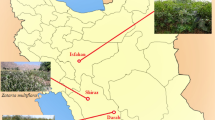Abstract
Extract of the leaves of the indigo plant (Polygonum tinctorium Lour.) was examined for antimicrobial activity against oral pathogenic bacteria. The indigo plant extract at concentrations of 1.74–3.48 mg/ml inhibited the growth of oral cariogenic and periodontopathic bacteria. Tryptanthrin, one of the components of indigo plant extract, showed the strongest antimicrobial effect at doses ranging from 3.13–25 μg/ml, indicating that this compound is one of the active ingredients. Furthermore, treatment of periodontopathic bacteria Porphyromonas gingivalis and Prevotella intermedia with the indigo plant extract for 3–8 h resulted in death of the bacteria in a dose-dependent manner, whereas Streptococcus mutans was not affected by the extract. Thus, for its antimicrobial and bactericidal effects on oral pathogens, indigo plant extract would provide useful material for preventing and treating periodontal diseases and dental caries.

Similar content being viewed by others
References
Lindquest B, Emilson CG (1991) Dental location of Streptococcus mutans and Streptococcus sobrinus in humans harboring both species. Caries Res 25:146–152
Schupbach P, Osterwalder V, Guggenheim B (1995) Human roots caries: microbiota in plaque covering sound, carious and arrested carious root surfaces. Caries Res 29:382–395
Marsh PD (1994) Microbial ecology of dental plaque and its significance in health and disease. Adv Dent Res 8:263–271
Slots J (1999) Update on Actinobacillus actinomycetemcomitans and Porphyromonas gingivalis in human periodontal disease. J Int Acad Periodontal 1:121–126
Petit MD, van Steenbergen TJ, Timmerman MF, de Graaff J, van de Velden U (1994) Prevalence of periodontitis and suspected periodontal pathogens in families of adult periodontitis patients. J Clin Periodontol 21:76–85
Tatefuji T, Aga M, Kunikata T, Ikeda M, Kurimoto M (1999) Antiviral effect of Polygonum tinctorium Lour. extracts on virus-infected cells. Nat Med 53:287–301
Inoue S, Takayama S, Ushio S, Iwaki K, Ohashi K, Masaki N, Fukuda S, Ikeda M, Kurimoto M (2000) Improvement of high fat diet-induced hyperlipidemia by Polygonum tinctorium Lour (in Japanese). Nat Med 54:261–264
Kimoto T, Yamamoto Y, Hino K, Koya S, Aga H, Hashimoto T, Hanaya T, Arai S, Ikeda M, Fukuda S, Kurimoto M (1999) Cytotoxic effects of substances in indigo plant (Polygonum tinctorium Lour.) on malignant tumor cells (in Japanese). Nat Med 53:72–79
Kimoto T, Hino K, Koya-Miyata S, Yamamoto Y, Takeuchi M, Nishizaki Y, Micallef MJ, Ushio S, Iwaki K, Ikeda M, Kurimoto M (2001) Cell differentiation and apoptosis of monocytic and promyelocytic leukemia cells (U-937 and HL-60) by tryptanthrin, an active ingredient of Polygonum tinctorium Lour. Pathol Int 52:315–325
Koya-Miyata S, Kimoto T, Micallef MJ, Hino K, Taniguchi M, Ushio S, Iwaki K, Ikeda M, Kurimoto M (2001) Prevention of azoxymethane-induced intestinal tumors by a crude ethyl acetate-extract and tryptanthrin extracted from Polygonum tinctorium Lour. Anticancer Res 21:3295–3300
Kimoto T, Koya S, Hino K, Yamamoto Y, Aga H, Hashimoto T, Masaki N, Mukai N, Hanaya T, Arai S, Ikeda M, Fukuda S, Kurimoto M (1999) Protection by indigo plant (Polygonum tinctorium Lour.) against renal oxidative damage in mice treated with ferric nitrilotriacetate (in Japanese). Nat Med 53:291–296
Ishihara T, Kohno K, Ushio S, Iwaki K, Ikeda M, Kurimoto M (2000) Tryptanthrin inhibits nitric oxide and prostaglandin E2 synthesis by murine macrophages. Eur J Pharm 407:197–204
Ishihara T, Okura T, Kohno K Tanimoto T, Ikegami H, Kurimoto M (2000) Polygonum tinctorium extract suppresses nitric oxide production by activated macrophages through inhibiting inducible nitric oxide synthase expression. J Ethnopharmacol 72:141–150
Micallef MJ, Iwaki K, Ishihara T, Ushio S, Aga M, Kunikata T, Koya-Miyata S, Kimoto T, Ikeda M, Kurimoto M (2002) The natural plant product tryptanthrin ameliorates dextran sodium sulfate-induced colitis in mice. Int Immunopharmacol 2:565–578
Hashimoto T, Aga H, Chaen H, Fukuda S, Kurimoto M (1999) Isolation and identification of anti-Helicobacter pylori compounds from Polygonum tinctorium Lour. Nat Med 53:27–31
Kataoka M, Hirata K, Kunikata T, Ushio S, Iwaki K, Ohashi K, Ikeda M, Kurimoto M (2001) Antibacterial action of tryptanthrin and kaempferol, isolated from indigo plant (Polygonum tinctorium Lour.), against Helicobacter pylori-infected Mongolian gerbils. J Gastroenterol 36:5–9
Honda G, Tabata M (1979) Isolation of antifungal principle tryptanthrin, from Strobilanthes Cusia O. Kuntze. Planta Med 36:85–86
Honda G, Tabata M, Tsuda M (1979) The antimicrobial specificity of tryptanthrin. Planta Med 37:172–174
Honda G, Tosirisuk V, Tabata M (1980) Isolation of an antidermatophytic, tryptanthrin, from indigo plants, Polygonum tinctorium and Isatis tinctoria. Planta Med 38:275–276
Sunayama T, Masaki N, Fukuda S (1999) Anti-inflammation of Polygonum tinctorium Lour. extract—clinical trials for candidiasis (in Japanese). Med Biol 139:29–32
Japan Society of Chemotherapy (1979) Standard method for the determination of minimum inhibitory concentration (MIC) for anaerobic bacteria (in Japanese). Chemotherapy 27:559–561
Lewis MA, Parkhurst CL, Douglas CW, Martin MV, Absi EG, Bishop PA, Jones SA (1995) Prevalence of penicillin resistant bacteria in acute suppurative oral infection. J Antimicrob Chemother 35:785–791
O-Brien-Simpson NM, Veith PD, Dashper SG, Reynolds EC (2003) Porphyromonas gingivalis gingipains: the molecular teeth of a microbial vampire. Curr Protein Pept Sci 4:409–426
Garrison SW, Nichols FC (1989) LPS-elicited secretory responses in monocytes: altered release of PGE2 but not IL-1 beta in patients with adult periodontitis. J Periodontal Res 24:88–95
Slater TF, Cheeseman KH, Davies MJ, Proudfoot K, Xin W (1987) Free radical mechanisms in relation to tissue injury. Proc Nutr Soc 46:1–12
Kimura S, Yonemura T, Kaya H (1993) Increased oxidative product formation by peripheral blood polymorphonuclear leukocytes in human periodontal diseases. J Periodontal Res 28:197–203
Shapira L, Borinski R, Sela MN, Soskolne A (1991) Superoxide formation and chemiluminescence of peripheral polymorphonuclear leukocytes in rapidly progressive periodontitis patients. J Clin Periodontol 18:44–48
Author information
Authors and Affiliations
Corresponding author
Rights and permissions
About this article
Cite this article
Iwaki, K., Koya-Miyata, S., Kohno, K. et al. Antimicrobial activity of Polygonum tinctorium Lour: extract against oral pathogenic bacteria. J Nat Med 60, 121–125 (2006). https://doi.org/10.1007/s11418-005-0025-z
Received:
Accepted:
Published:
Issue Date:
DOI: https://doi.org/10.1007/s11418-005-0025-z




